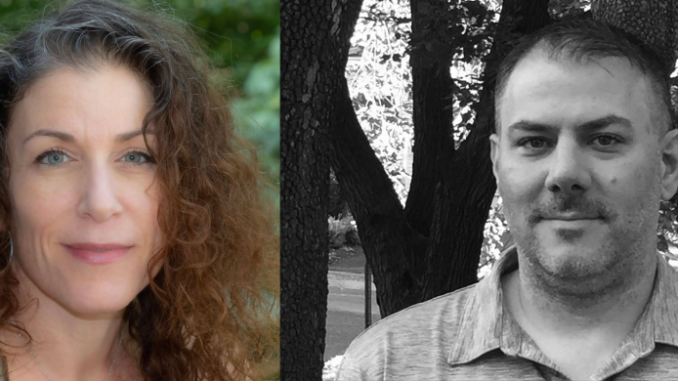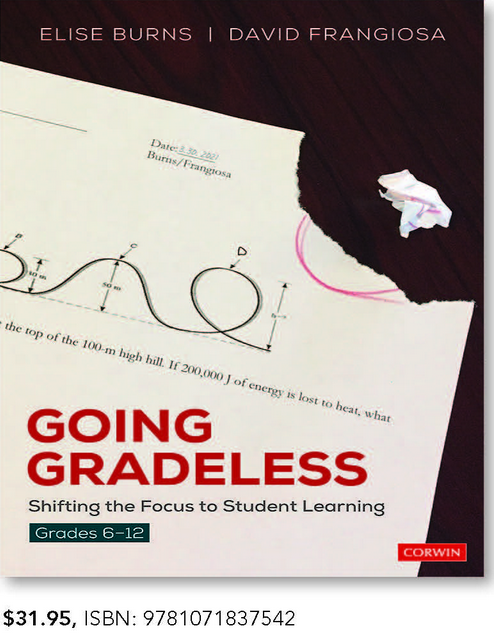
MONTVALE, N.J.—Pascack Hills High School science teachers Elise Burns and David Frangiosa have taken a different approach to learning in the classroom. Most teachers use the traditional method of teaching a subject: testing the students on it, giving a letter or number grade on the assessment, and moving on to the next lesson.
Instead, Burns and Frangiosa did away with traditional grades in the classroom. They have essentially “gone gradeless.” And they say the approach produces valuable results other educators should consider.
In March the two published a book, “Going Gradeless, Grades 6–12: Shifting the focus to student learning” (Corwin, paperback and electronic) in which they reflect on their teaching philosophies and practices centered around reforming assessment, reducing stress, and strengthening learning through the alternative learning method of standards-based grading.
“We never really intended to write a book,” Frangiosa told Pascack Press last week. “We do student surveys mid-year and at the end of the year to get student feedback, both positive and negative. We conduct these surveys so we know how we can make class better. We felt the need to share the data we compiled.”
Frangiosa said that he and his writing partner had almost 400 student surveys at the time of writing the book.
He said that he decided to go gradeless during the 2016–2017 school year. Principal Tim Wieland, then Hills’ vice principal—he started his career in education as a mathematics teacher at Pascack Valley High School in 2004—remarked he’d wanted to try out a gradeless classroom. Frangiosa volunteered that he wanted his classroom to be the pilot gradeless classroom.
How it works

The book is aimed at teachers looking to make the shift to standard-based learning, with a focus on grades 6–12.
Standards-based grading is an alternative learning method based on demonstration of mastery rather than demonstration of completion.
Traditional grading methods use letters and percentages, while standards-based grading uses a different type of grading scale. The standards-based grading scale is typically 1–4, with each number representing a different level of mastery. 1’s demonstrate little to no mastery of a topic; 4’s represents the students exceeding the target expectations.
Another difference: a unit is often broken into multiple “learning targets” as opposed to one final target, such as a traditional test.
When starting a new topic, many students will start out with 1’s, as the material is new and they have no prior knowledge to build upon. As the unit progresses, students can reach higher levels of mastery applied to more complex material.
Moving up a level of mastery shows student growth. Should a student not reach the next level of mastery, the grading scale and the teacher provide helpful feedback.
The grading scale allows the teacher to be able to regularly measure student progress as opposed to using a single assessment as a measure of how well the student knows the material.
Frangiosa told Pascack Press last week that the mood in the classroom changed—relaxed, and became more about mastery—when he made the shift to go gradeless.
He said, “I was frustrated that students weren’t reaching the potential I knew they had. All of my conversations with students had been centered around grades. They were asking ‘How can I get a better grade on this assignment?’ rather than ‘How can I improve my skills and better learn the material?’”
He added, “I noticed my relationships with students have improved. The atmosphere is more collaborative and pleasant. Students work together better and are more willing to ask each other for help when they need it. When students talk to me, it’s about getting help to better learn the material as opposed to asking about a grade. There’s less stress on both ends.”
One reviewer on the publisher’s site said, “This book shows there is a way to hold students accountable while allowing them to step away from the stress of traditional grading. What a win for moving education forward!”
Jay Adams, a teaching consultant, said on Twitter that the book “was excellently done, full of instantly-implementable tips and rubrics and a thorough explanation of benefits, costs, and their process.”
The publisher’s website notes Frangiosa has spent 14 years as a high school science teacher, teaching biology, chemistry, physics and a number of science electives. Over that time, he has been a driving force in many initiatives across multiple districts.
It says he developed, wrote curriculum for, and taught two courses for a medical academy. “As part of this initiative, high school students were placed in allied health internships at a local hospital. This program piloted a paperless classroom that led to a district-wide one-to-one program.”
Shortly after moving to Pascack Valley Regional High School District, he began conducting action research on grade reform. As a result of this work, he was asked to be on a county-wide Growth Learning Assessment and Mindset (GLAM) committee.
Burns has been a science teacher for 30 years, teaching physics, chemistry, biology, math, and earth science. She says her work is characterized by trying new technology and approaches in order to provide the best possible learning experience for kids.
Burns and Frangiosa worked with teachers from other content areas during the editing and peer review process to ensure that the practices in the book can be applied to any subject in the classroom.
The book contains examples of approaches to take for standards-based learning along with sample assessments, student work samples, and feedback from the student surveys.
Frangiosa said that he has heard that other teachers are investigating alternative methods to traditional grading in the classroom.
“Other classrooms at Pascack Hills have not gone gradeless, but teachers are looking into alternative approaches to assessing students in classes like math and English,” he said.
He added, “We’re having more conversations about how and why we grade so we can better teach our students.”
